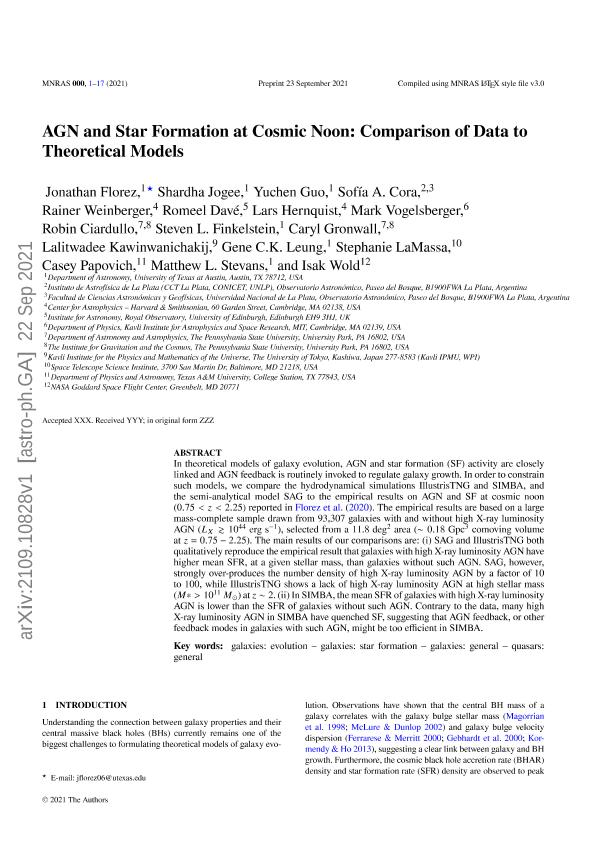Mostrar el registro sencillo del ítem
dc.contributor.author
Florez, Jonathan
dc.contributor.author
Jogee, Shardha
dc.contributor.author
Guo, Yuchen
dc.contributor.author
Cora, Sofia Alejandra

dc.contributor.author
Weinberger, Rainer
dc.contributor.author
Davé, Romeel
dc.contributor.author
Hernquist, Lars
dc.contributor.author
Vogelsberger, Mark
dc.contributor.author
Ciardullo, Robin
dc.contributor.author
Finkelstein, Steven L.
dc.contributor.author
Gronwall, Caryl
dc.contributor.author
Kawinwanichakij, Lalitwadee
dc.contributor.author
Leung, Gene C. K.
dc.contributor.author
LaMassa, Stephanie
dc.contributor.author
Papovich, Casey
dc.contributor.author
Stevans, Matthew L.
dc.contributor.author
Wold, Isak
dc.date.available
2022-02-25T16:39:54Z
dc.date.issued
2021-11
dc.identifier.citation
Florez, Jonathan; Jogee, Shardha; Guo, Yuchen; Cora, Sofia Alejandra; Weinberger, Rainer; et al.; AGN and star formation at cosmic noon: comparison of data to theoretical models; Wiley Blackwell Publishing, Inc; Monthly Notices of the Royal Astronomical Society; 508; 1; 11-2021; 762-780
dc.identifier.issn
0035-8711
dc.identifier.uri
http://hdl.handle.net/11336/152749
dc.description.abstract
In theoretical models of galaxy evolution, active galactic nucleus (AGN) and star formation (SF) activity are closely linked and AGN feedback is routinely invoked to regulate galaxy growth. In order to constrain such models, we compare the hydrodynamical simulations IllustrisTNG and SIMBA, and the semi-analytical model SAG to the empirical results on AGN and SF at cosmic noon (0.75 < z < 2.25) reported in Florez et al. (2020). The empirical results are based on a large mass-complete sample drawn from 93 307 galaxies with and without high X-ray luminosity AGN (LX ≳ 1044 erg s−1), selected from a 11.8 deg2 area (∼0.18 Gpc3 comoving volume at z = 0.75?2.25). The main results of our comparisons are: (i) SAG and IllustrisTNG both qualitatively reproduce the empirical result that galaxies with high X-ray luminosity AGN have higher mean SFR, at a given stellar mass, than galaxies without such AGN. SAG, however, strongly overproduces the number density of high X-ray luminosity AGN by a factor of 10?100, while IllustrisTNG shows a lack of high X-ray luminosity AGN at high stellar mass (M∗>1011M⊙) at z ∼ 2. (ii) In SIMBA, the mean SFR of galaxies with high X-ray luminosity AGN is lower than the SFR of galaxies without such AGN. Contrary to the data, many high X-ray luminosity AGN in SIMBA have quenched SF, suggesting that AGN feedback, or other feedback modes in galaxies with such AGN, might be too efficient in SIMBA.
dc.format
application/pdf
dc.language.iso
eng
dc.publisher
Wiley Blackwell Publishing, Inc

dc.rights
info:eu-repo/semantics/openAccess
dc.rights.uri
https://creativecommons.org/licenses/by-nc-sa/2.5/ar/
dc.subject
galaxies: evolution
dc.subject
galaxies: star formation
dc.subject
galaxies: general
dc.subject
quasars: general
dc.subject.classification
Astronomía

dc.subject.classification
Ciencias Físicas

dc.subject.classification
CIENCIAS NATURALES Y EXACTAS

dc.title
AGN and star formation at cosmic noon: comparison of data to theoretical models
dc.type
info:eu-repo/semantics/article
dc.type
info:ar-repo/semantics/artículo
dc.type
info:eu-repo/semantics/publishedVersion
dc.date.updated
2022-02-04T13:30:09Z
dc.journal.volume
508
dc.journal.number
1
dc.journal.pagination
762-780
dc.journal.pais
Reino Unido

dc.description.fil
Fil: Florez, Jonathan. University of Texas at Austin; Estados Unidos
dc.description.fil
Fil: Jogee, Shardha. University of Texas at Austin; Estados Unidos
dc.description.fil
Fil: Guo, Yuchen. University of Texas at Austin; Estados Unidos
dc.description.fil
Fil: Cora, Sofia Alejandra. Consejo Nacional de Investigaciones Científicas y Técnicas. Centro Científico Tecnológico Conicet - La Plata. Instituto de Astrofísica La Plata. Universidad Nacional de La Plata. Facultad de Ciencias Astronómicas y Geofísicas. Instituto de Astrofísica La Plata; Argentina
dc.description.fil
Fil: Weinberger, Rainer. Harvard-Smithsonian Center for Astrophysics; Estados Unidos
dc.description.fil
Fil: Davé, Romeel. University of Edinburgh; Reino Unido
dc.description.fil
Fil: Hernquist, Lars. Harvard-Smithsonian Center for Astrophysics; Estados Unidos
dc.description.fil
Fil: Vogelsberger, Mark. Kavli Institute for Astrophysics and Space Research; Estados Unidos
dc.description.fil
Fil: Ciardullo, Robin. The Pennsylvania State University; Estados Unidos
dc.description.fil
Fil: Finkelstein, Steven L.. The University Of Texas At Austin; Estados Unidos
dc.description.fil
Fil: Gronwall, Caryl. The Pennsylvania State University; Estados Unidos
dc.description.fil
Fil: Kawinwanichakij, Lalitwadee. The University of Tokyo; Japón
dc.description.fil
Fil: Leung, Gene C. K.. The University Of Texas At Austin; Estados Unidos
dc.description.fil
Fil: LaMassa, Stephanie. Space Telescope Science Institute; Estados Unidos
dc.description.fil
Fil: Papovich, Casey. Texas A&M University; Estados Unidos
dc.description.fil
Fil: Stevans, Matthew L.. The University Of Texas At Austin; Estados Unidos
dc.description.fil
Fil: Wold, Isak. Nasa Goddard Space Flight Center; Estados Unidos
dc.journal.title
Monthly Notices of the Royal Astronomical Society

dc.relation.alternativeid
info:eu-repo/semantics/altIdentifier/url/https://academic.oup.com/mnras/article/508/1/762/6372912
dc.relation.alternativeid
info:eu-repo/semantics/altIdentifier/doi/http://dx.doi.org/10.1093/mnras/stab2593
Archivos asociados
